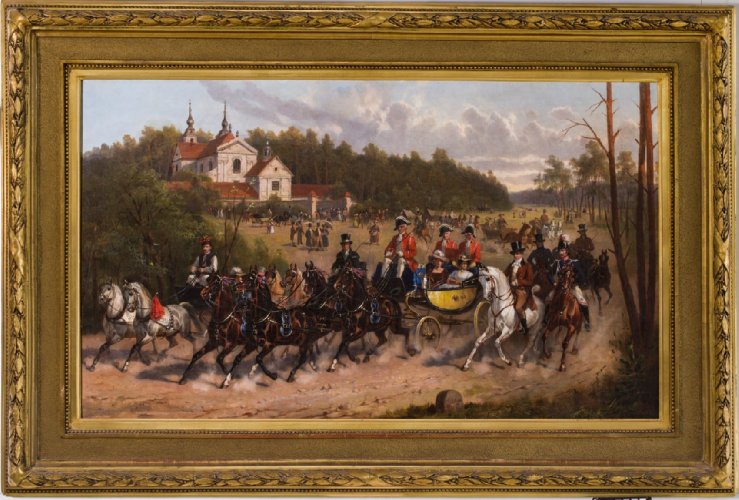Description:
Joseph Brodowski (1828-1900) was the son of the painter Antoni Brodowski. From 1844 to 1850 he studied at the Warsaw School of Fine Arts. He graduated with honors. His professor was, among others, Rafał Hadzewicz. Then he left with Wojciech Garson to Russia. In the years 1853-1856 he continued his studies at the Academy of Fine Arts in St. Petersburg under the batalist Boris Pavlovich Willewalde. In 1857 he began an internship in Paris under the guidance of Horace Vernet. From France he went to Italy, to finally return to Warsaw in 1859. He collaborated with Juliusz Kossak. He created illustrations for the “Illustrated Weekly”.
Description of the painting:
The painting “Return from Bielany” was in the Rogalin gallery building until 1938. In the years 1939-1945 it was in the possession of Kulturamt der Gauhauptstadt Posen. The horse motif presented by the painter had already appeared earlier in his work. It was depicted in the painting from 1872. Joseph Brodowski, fascinated by the animalistic motif, immortalized it in a varied scenery of landscapes or battle scenes.
“In Bielany near Warsaw” Joseph Brodowski presents a characteristic image of the daily life of the inhabitants of Warsaw – the return from the trip to Bielany. “For a long time, Bielany have been traditionally associated with Warsaw. In the course of the last hundred years, the tradition of trips to Bielany has undergone a gradual evolution. People went there in elegant carriages, ships, on foot […] The ways of locomotion changed and the character of the crowds visiting Bielany changed. The essence of the tradition remained the same – a lively desire to break out of the stuffy city into a real and shady forest; sometimes a subconscious desire to commune with nature, not changed by man”.
The painter depicts a procession of horses and accompanying figures. Dust and sand rise from the horse hooves. They are depicted in full speed, their galloping seems to be almost palpable. The crowd of harnessed carriages begins its journey from a point located in the center of the pictorial field. Then it forms an S-shape to emphasize the first plan of two pairs of dark-gray horses pulling a yellow, open carriage (calèche in English harness). This is where the viewer’s attention focuses. The coachman sitting on the box and two servants dressed in red liveries have their heads covered with black two-horns. Two ladies are in the carriage and accompanied by gentlemen riding next to it. On the right side of the harness, a man dressed in a Krakow costume with a red cap is shown. He drives a two-horse harness of gray horses. Attention is drawn to the meticulousness with which the anatomical details of the painted horses and the costumes adorning the figures are faithfully reproduced.
On the right side of the pictorial field, the monastery complex of the Camaldolese on Bielany was captured. Two towers of the church complex dedicated to the Immaculate Conception of the Blessed Virgin Mary, St. Joseph and St. Ambrose, as well as the monastery buildings surrounded by a high brick wall are visible. Tired of city life, guests are walking around the buildings. In a moment they will climb into the empty carriages waiting for them and join the noisy procession.
The outlined on the horizon golden-orange halo of light is a sign of the setting sun. Lovers of suburban rides are returning to their homes. They rush away, leaving behind the experiences of the past afternoon and the nature surrounding them from all sides.


